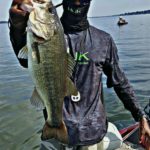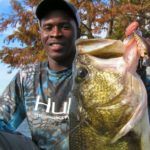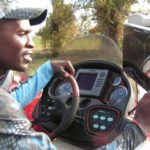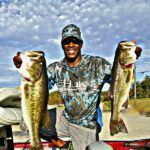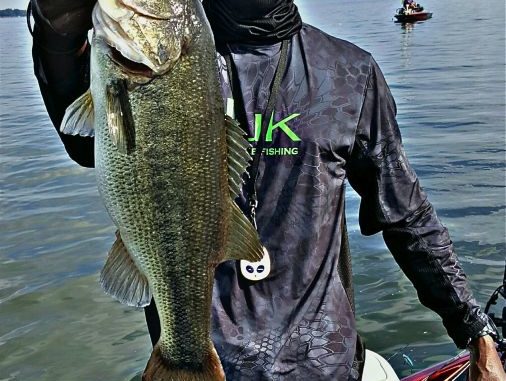
While other anglers are catching bass after bass, this Lincoln Parish sheriff’s deputy is focused on five fish a day. And that’s given him the inside track on how to catch lunkers.
Being a police officer today is a pretty stressful profession. What they see, what they deal with — it’s a lot.
And in many corners, policemen don’t get the respect they deserve.
As a Lincoln Parish deputy sheriff, Ruston resident Sontus Mitchell knows all about that.
But he does know how to handle the stress.
“I go fishing,” Mitchell said. “It’s just me and the water. I can put everything else behind me and just concentrate on fishing.”
There is still a victim in that situation, though. Largemouth bass: lunker largemouth bass.
Mitchell is known for catching them, and his record on the tournament trails of Northeast Louisiana bears that out.
His specialty is cuffing big bass.
“I love catching big bass,” he said. “Over the years I have disciplined myself to fish baits and techniques that lead me to catch big bass. It’s hard to do that.
“I have to give up catching big numbers of bass, and my goal is to fish where I get five big bites every time I go.”
That also just happens to be the number of fish he can weigh in during a bass tournament.
“No doubt, that’s what I practice for and fish for,” Mitchell said. “I love competitive bass fishing. And the way to be successful at that is to catch big bass.”
Mitchell winning tournaments won’t help me or you. But if we follow what he does and listen to his advice, it can help us catch more big fish — whether fishing competitively or not.
The angler fishes Lake D’Arbonne, Lake Claiborne, Caney Lake, the Red River and even Black Lake at Campti.
But he does the same thing no matter what lake he’s on, from types of structure to baits and techniques.
“The key to catching big bass on any of these lakes is, first of all, spending some time on the water and learning the habits of big bass,” Mitchell said. “Where do they stay in different seasons? What makes them bite? How do conditions affect them?
“Then, you have to learn to fish slow and methodically.”
Mitchell doesn’t just mean slow: He means real slow.
Slower than most people allow themselves to fish.
Being methodical means locating fish and working structure thoroughly, patiently and from every angle.
And did we mention he fishes slow?
The next thing he recommends is using big baits.
“You aren’t going to catch as many fish on big baits, but you are going to catch big fish on big baits,” Mitchell said.
The good thing about this time of the year is big bass are a little bit easier to find, he said.
“You need to concentrate on 1 foot of water to 5 feet of water,” Mitchell explained. “I look for laydowns, stumps, structure that is in shallow water. That is where the fish will be.
“Some people may not think an 8-pound bass would be in a foot of water, but with the spawning season still underway, they will be.”
Of course, it’s hard to battle the crowds and catch those fish.
“You have to find areas that don’t get disturbed a lot, and fish them quietly and slowly,” Mitchell said.
And a methodical approach to picking apart the cover can’t be stressed enough because the fish just aren’t going to charge a bait.
“You have to put the lure right where they are, not just close to them,” Mitchell said.
Here’s Mitchell’s best advice for spring lunkers”
Go big
“As I said, I use big baits: big plastic worms, big square-lip crankbaits and big slow-rolling spinnerbaits,” Mitchell said. “I like white or chartreuse, big-bladed spinnerbaits. I like big 7- to 9-inch plastic worms and creature baits. Try those.
“But if you aren’t comfortable with those, start with a weightless Senko. You can rig it Texas style, wacky style or on a South Carolina rig. But all you have to do is throw it in structure, let it sit and then give it a jerk. It’s easy to fish and the fish really nail it.”
If you opt for a Senko, however, Mitchell provided one piece of advice.
“When you get a bite, don’t set the hook until you feel the fish pull back,” he said. “Bass do inhale the lure, but if they feel you tugging, they’ll spit it out quickly.
“Let them have it a second before you set the hook.”
Narrow down the search
This time of the year is one of the easiest to approach the right parts of the lake. In later spring, summer and fall, you need to use electronics to find fish.
But this time of year, just concentrate on the shore.
“Onshore structure is the easiest to locate,” Mitchell said. “Old laydowns, brush tops and cypress trees with big root systems hold big bass. I’d say 1 foot to 5 feet deep.
“We are still having some cold fronts and, if that happens, the fish will move out to the nearest deep water, creek channel or ledge. The fish will still be there; they’ll just be harder to catch.”
Under those conditions, he goes to a suspending Rogue if the fish aren’t on the bottom or to a football jig if they are.
Just give both lures a try.
“Remember to fish slow,” Mitchell said. “Fish your lure slow. Fish the area slow. No matter how slow you think you are going, slow down a little more.
“Being methodical and making sure you cover the structure you are fishing is so important. I can’t overemphasize that.”
Make your own luck
Sometimes catching a big bass is luck: You throw the right lure in the right place at the right time.
But, for Mitchell, doing that on a regular basis is much more than luck.
“I put in my time on the water, and I make myself fish the way I know I have to in order to catch big bass,” he said. “It’s what I do.”
And you don’t have to take him to court on that one. There are plenty of witnesses around Northeast Louisiana to confirm the facts without a trial.
